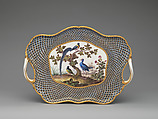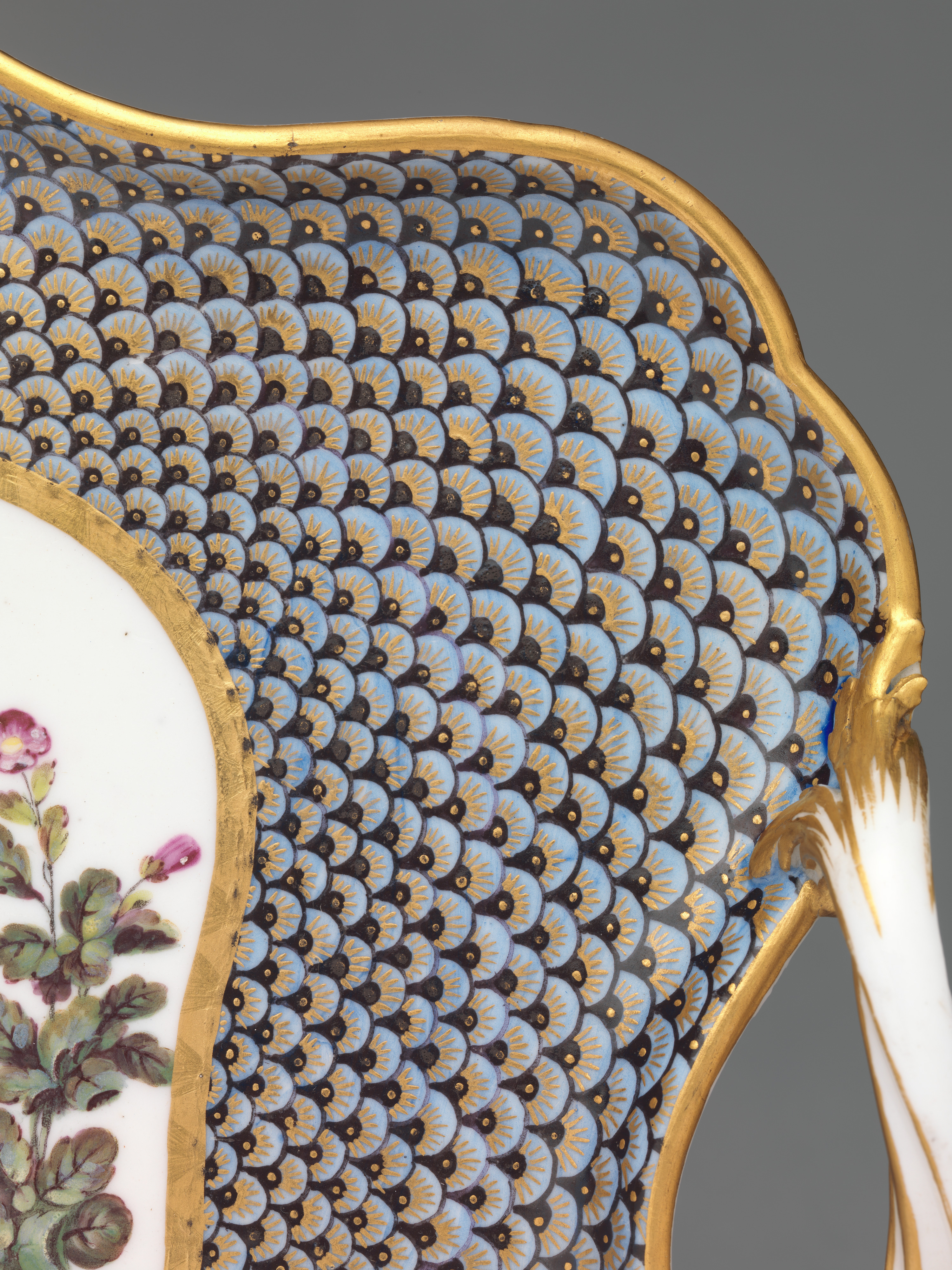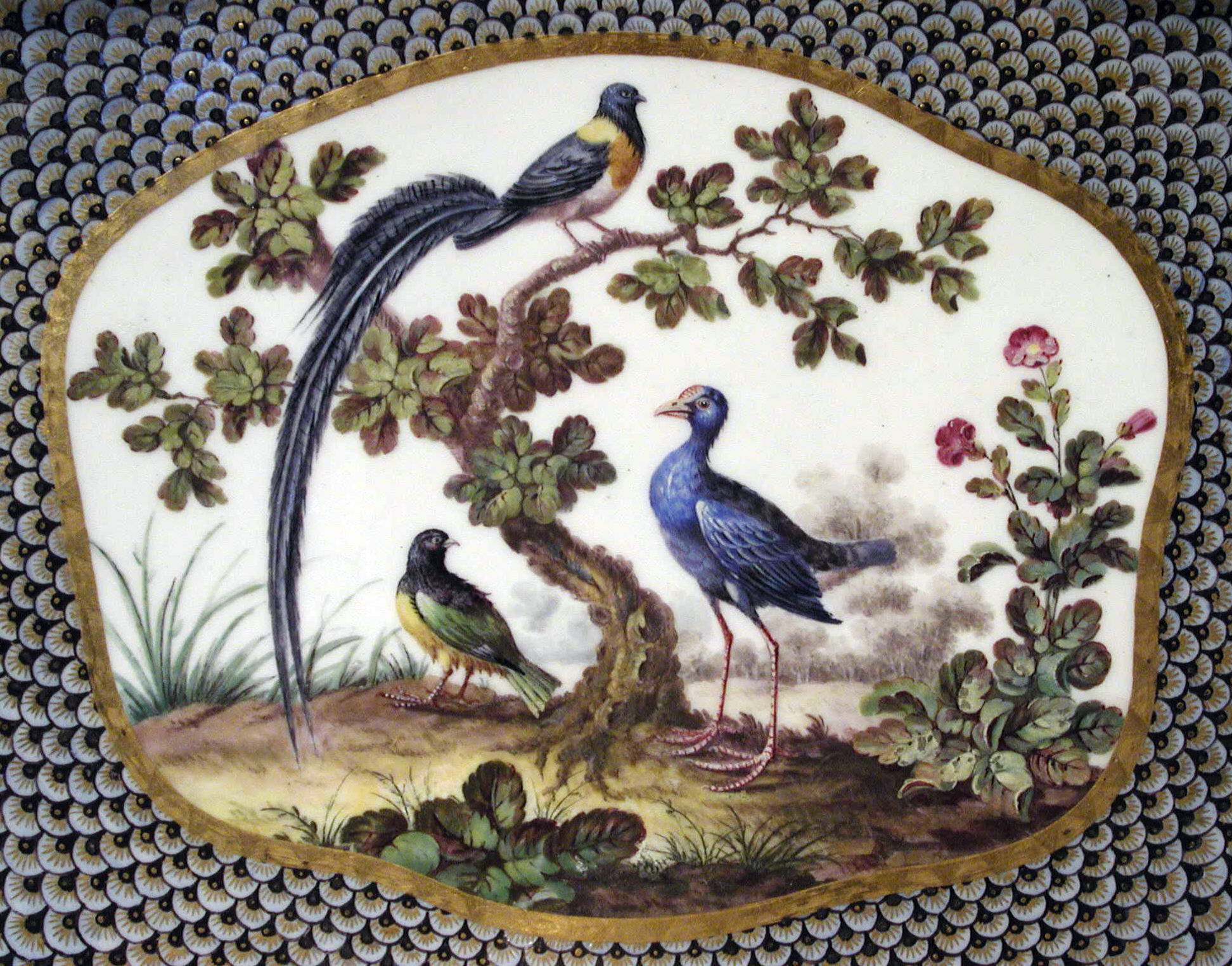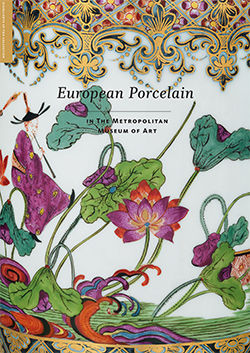Tray (plateau Duplessis) (part of a service)
Manufactory Sèvres Manufactory French
Decorator François-Joseph Aloncle French
Not on view
Birds were depicted on Vincennes and then Sèvres porcelain from the earliest years of production at Vincennes, but they were painted as fanciful creations and employed as decorative elements with no concern for fidelity to actual birds. Most of these early painted creatures had little delineation and their coloring was entirely arbitrary. It was not until the late 1760s that the painters at Sèvres began depicting birds that were accurate representations of those found in nature, rendered with specificity and accurate coloration. The impetus for this change was the availability of hand-colored etchings of birds published in George Edwards’s (British, 1694–1773) A Natural History of Birds (1743–51) and his Gleanings of Natural History, issued in a series of volumes between 1747 and 1764.[1] The first pieces of Sèvres porcelain decorated with birds copied from Edwards’s prints were produced for Charles Lennox (1735–1806), 3rd Duke of Richmond, who had lent his own copies of Edwards’s volumes to the factory to serve as models.[2] A dessert and tea service with ornithological decoration derived from Edwards’s works was completed in 1766 for Richmond initiating a fashion for this new type of bird painting that was to last only a relatively short time.
The most ambitious of the bird painting produced at Sèvres in the 1760s is found on a dessert service made for the Russian Count Kyril Razumovsky (1728–1803).[3] Produced in 1767, the service comprised 108 pieces that included plates, bowls of different shapes, footed stands, sugar bowls, bottle and glass coolers, and ice cream cups, each of which was decorated with at least one reserve of a bird in an abbreviated landscape, with some of the larger pieces in the service having more elaborate compositions with two birds. Five of the seven volumes of Edwards’s Natural History and Gleanings were used as sources by the painters at Sèvres.[4] A distinguishing feature of the Razumovsky service is the presence of inscriptions in black enamel on the underside of each piece indicating the name of the bird depicted and, in most instances, the part of the world in which it lived. This eighteenth-century interest in the actual species and their habitat was a reflection of the Enlightenment’s preoccupation with understanding the natural world, and the exotic origins of many of Edwards’s subjects further enhanced the appeal of this subject matter.
The substantial effort required to inscribe the names of the birds and their origin on the undersides of objects with bird paintings must have proved too time- consuming and thus too costly for the factory, and not all of the Sèvres porcelain decorated with birds after Edwards have this identification. Most of the works made at the factory with this type of ornithological decoration are wares for dinner services, but at least three tea services painted in this manner are known. The earliest of these tea services was produced for Richmond, cited above, and two were produced in 1767, including the Museum’s tea service.[5]
A source in Edwards has not yet been identified for the various birds depicted on the Museum’s service, but the format of each reserve on the tea wares closely follows the one established by the decoration on the Razumovsky service. A bird, usually depicted in profile, rests on a tree branch, and the tree’s leaves are carefully placed so as not to obscure the bird’s features.[6] Additional vegetation is included to suggest a landscape, with the scale of the reserve determining the amount of detail. A single bird is painted on each of the components of the tea service with the exception of the tray, which depicts three birds in one of the more elaborate compositions to be found within the entire genre of bird painting after Edwards as practiced at Sèvres. All the pieces in the tea service, excluding the milk jug, bear the mark of François- Joseph Aloncle (French, 1734–1781), one of the most accomplished bird painters at the factory. Aloncle was one of four Sèvres painters specializing in birds who worked on the Razumovsky service, and his decoration of the tea service must have been more or less simultaneous with his work on the Razumovsky objects. The quality of Aloncle’s bird painting varied in the course of his long career at Sèvres,[7] but the reserves on this tea service represent some of his finest work.
Aloncle’s painting is effectively enhanced by the unusual treatment of the ground used for the service. Composed of overlapping scales painted in dark blue and gold on a pale blue ground, the resulting pattern achieves a tonality that perfectly complements the artist’s cool palette. In addition, the scales suggest stylized peacock feathers, subtly reinforcing the subject matter of the reserves. This type of ground deco-ration was used rarely at Sèvres,[8] perhaps because it would have been so costly to create in terms of labor. On all the pieces of the service, the scales are graduated in size to align with the changing proportions of each component. This is particularly noticeable on the tray where the scales increase in size as they spread toward the rim, skillfully accommodating the tray’s undulating profile.
Linda H. Roth has persuasively argued that this model of tea service was called a Déjeuner Duplessis at the factory,[9] where the name of the model of the tray was applied to the tea service itself. While there is no documentary evidence to prove that Duplessis designed the tray, its sinuous, undulating profile and its subtly twisting handles create a sense of movement and a sculptural presence that are hallmarks of the factory’s prodigiously talented designer of three-dimensional models.
Footnotes
(For key to shortened references see bibliography in Munger, European Porcelain in the Metropolitan Museum of Art. NY: The Metropolitan Museum of Art, 2018)
1 For a thorough exploration of this subject, see S. Schwartz 2005.
2 Zelleke 1991.
3 The service, its production, and its history are explored at length in S. Schwartz 2005.
4 Ibid., p. 17.
5 The second is a tea service comprising a teapot, sugar bowl, milk jug, and four cups and saucers with decoration by Antoine-Joseph Chappuis (French, active 1761–87) in the Frick Collection, New York (18.9.21–18.9.31).
6 S. Schwartz 2005, p. 31.
7 Aloncle was active at Sèvres from 1758 to 1781; Peters 2005, vol. 1, p. 15.
8 The most ambitious examples of Sèvres porcelain with this ground known to the author are three vases composing a garniture in the Victoria and Albert Museum, London (171- 1879, 172&A- 1879); other examples include a tea service in Ader Tajan/Hôtel George V, Paris, sale cat., November 18, 1992, no. 62; a tray in Christie’s, New York, sale cat., October 21, 2005, no. 140; a cup and saucer in Christie’s, New York, sale cat., October 21–22, 2010, no. 625. A closely related ground was used for a tea service in the State Hermitage Museum, Saint Petersburg; Biriukova and Kazakevich 2005, pp. 300–302, nos. 1148–51.
9 Linda H. Roth in Roth and Le Corbeiller 2000, pp. 197–99.
Due to rights restrictions, this image cannot be enlarged, viewed at full screen, or downloaded.
This artwork is meant to be viewed from right to left. Scroll left to view more.





